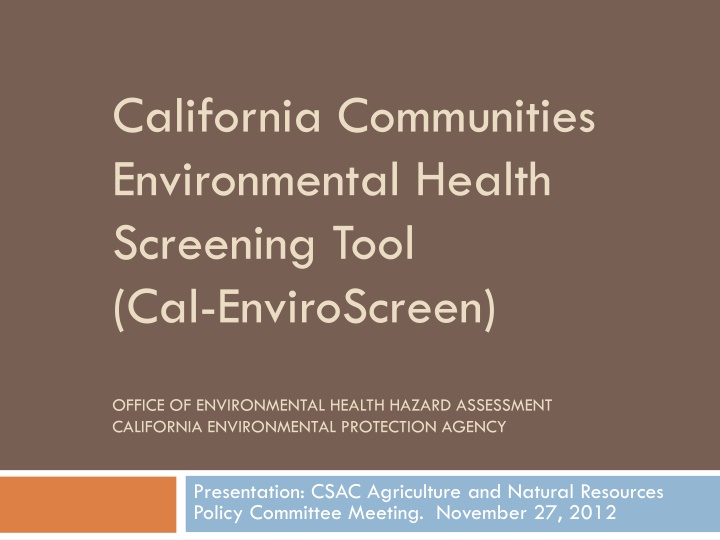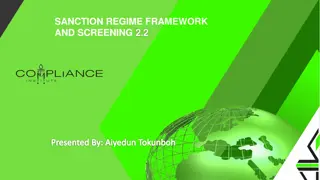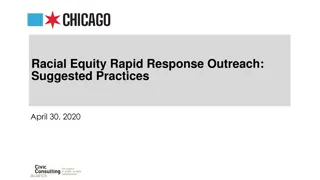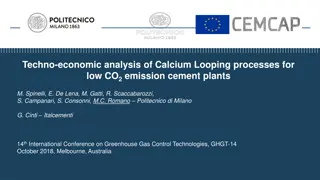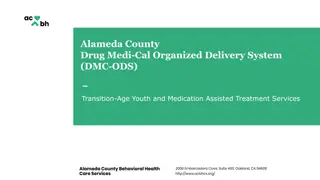California Communities Environmental Health Screening Tool (Cal-EnviroScreen) Overview
California Communities Environmental Health Screening Tool, known as Cal-EnviroScreen, is a program that focuses on environmental justice, aiming to ensure fair treatment for all individuals concerning environmental laws. The initiative addresses concerns related to cumulative impacts of pollution on low-income areas with high minority populations. It originated from statutory definitions of environmental justice and has undergone various processes to develop guidance on evaluating cumulative impacts in communities. The screening tool allows for the identification of areas with high pollution impacts and vulnerabilities. For more information, visit http://oehha.ca.gov/ej.
Download Presentation

Please find below an Image/Link to download the presentation.
The content on the website is provided AS IS for your information and personal use only. It may not be sold, licensed, or shared on other websites without obtaining consent from the author.If you encounter any issues during the download, it is possible that the publisher has removed the file from their server.
You are allowed to download the files provided on this website for personal or commercial use, subject to the condition that they are used lawfully. All files are the property of their respective owners.
The content on the website is provided AS IS for your information and personal use only. It may not be sold, licensed, or shared on other websites without obtaining consent from the author.
E N D
Presentation Transcript
California Communities Environmental Health Screening Tool (Cal-EnviroScreen) OFFICE OF ENVIRONMENTAL HEALTH HAZARD ASSESSMENT CALIFORNIA ENVIRONMENTAL PROTECTION AGENCY Presentation: CSAC Agriculture and Natural Resources Policy Committee Meeting. November 27, 2012
Program Origins in Environmental Justice Statutory definition of EJ Environmental justice means the fair treatment of people of all races, cultures, and incomes with respect to the development, adoption, implementation and enforcement of environmental laws, regulations, and policies. Gov. Code 65040.12(e), 1999 Cal/EPA s responsibilities Required development of interagency environmental justice strategy for Cal/EPA (completed 2004) Required each of the Cal/EPA boards and departments to review, identify, and address program obstacles impeding the progress of environmental justice Public Resources Code 71113, 2000 2
Basis of concern for cumulative impacts Numerous studies have shown that multiple pollution sources are disproportionately concentrated in low- income communities with high-minority populations. Studies have reported communities with certain socioeconomic factors (i.e. low-income, low- education) have increased sensitivity to pollution. Combination of multiple pollutants and increased sensitivity in these communities can result in higher cumulative pollution impacts. 3
How We Got Here (Process) California Environmental Justice Advisory Committee Recommended cumulative impacts as an important EJ issue Environmental Justice Action Plan (October 2004) Called for guidance on cumulative impacts CA Interagency Working Group on Environmental Justice Adopted working definition for cumulative impacts Office of Environmental Health Hazard Assessment Designated lead on cumulative impacts guidance development Convened a Work Group of external stakeholders to provide advice. 4
December 2010 Project Report Described an approach to evaluating cumulative impacts across California. Screening tool for comparing the cumulative impacts of multiple pollution sources in CA communities, while accounting for socioeconomic factors that that can increase a community s vulnerability to pollution. Identify communities with high cumulative impacts. Available on the OEHHA website at: http://oehha.ca.gov/ej 5
2012 Draft CalEnviroScreen Tool Identifies 19 indicators of environmental and socioeconomic conditions. Analyzes indicators in 1800 CA zip codes. Presents a broad picture of the relative burdens communities face from environmental pollution. Reflects a work in progress
Stakeholder Engagement Process for Cal-Enviroscreen Conducted 12 public workshops Cumulative Impacts Precautionary Approach ( CIPA ) Workgroup 7 Regions around the state Business Communities, Local Government, Tribes Academic workshop to receive detailed comments from experts in the field Received numerous oral comments and questions (e.g., > 1000) Presented to California Council for Environmental and Economic Balance, CAPCOA Board, others Comment period ended October 16 Received 29 written submissions commenting on tool 7
Working Definition Cumulative impacts means exposures, public health or environmental effects from the combined emissions and discharges in a geographic area, including environmental pollution from all sources, whether single or multi-media, routinely, accidentally, or otherwise released. Impacts will take into account sensitive populations and socioeconomic factors, where applicable and to the extent data are available. -- Cal/EPA Interagency Working Group on Environmental Justice 8
Primary Components Sensitive Populations Exposures Public Health Effects Socioeconomic Factors Environmental Effects 9
Interpretation of Major Terms Exposures Contact with pollution Disease and other health conditions that increases susceptibility to pollutants Public Health Effects Environmental Effects Adverse environmental conditions caused by pollutants Populations with biological traits that may magnify the effects of pollutant exposures Sensitive Populations Socioeconomic Factors Community characteristics that result in increased vulnerability to pollutants 10
Proposed Geographical Unit: ZIP Code1 Familiar scale Map of ZIP Code Coverage Publicly established Redding !( Legend CA Interstates ZIP Code Boundaries Sacramento Public recognition California Topography !( San Francisco !( Not too large to discern differences Bay Area Fresno !( Bakersfield !( Not too small To lose relevant data (e.g., certain health data) Los Angeles !( Los Angeles Area San Diego !( 1 A representation of ZIP codes, called ZCTAs (ZIP Code Tabulation Areas) is available from the Census Bureau. ZCTAs are referred to as ZIP codes in this presentation. 11
Components are Characterized by Indicators Pollution Burden Population Characteristics Socio- economic Factors Public Health Effects Environmental Effects Sensitive Populations Exposures Ozone concentrations Low birth weight rate Clean-up sites (brownfields) Prevalence of children Educational attainment PM 2.5 concentrations Traffic density Asthma ER visit rate Leaking under- ground storage tanks and cleanups Prevalence of elderly Household income Heart disease mortality rate* Poverty Pesticide use Solid waste sites and facilities and hazardous waste facilities Percent non- white Cancer Mortality rate* Toxic releases from facilities * under development or revision Drinking water quality* Impaired water bodies 12
Criteria for indicator selection Provide a good measure of the contribution to the component Pollution burden indicators should relate to issues that may be actionable by Cal/EPA Population characteristic indicators should relate to demographic factors that may influence vulnerability to disease Publicly available Statewide and location-based information Good quality data (e.g., covers the state, accurate, current) 13
Range of Scores for Components Component Range of Possible Scores Exposures 1-10 Environmental effects 1-5 Public health effects 1-5 Sensitive populations 1-3 Socioeconomic factors 1-3 Cumulative impact 6-120 Considering revised scoring based on comments. 15
Indicator: Ozone Air Resources Board s Air Monitoring Network Indicator: Daily maximum 8-hour ozone concentrations for the summer season Interpolated from nearest monitors to geographic center of the ZIP code by ARB Three year (2007-2009) average Assign a percentile (>0 100) to all California ZIP codes 16
Preliminary Statewide Map: Ozone Ozone Interpolated daily maximum 8-hour ozone concentrations, summer season (ppm) Redding !( < 0.033 0.048 - 0.050 0.033 - 0.036 0.051 - 0.053 0.037 - 0.041 0.054 - 0.057 Sacramento 0.042 - 0.044 0.058 - 0.061 !( 0.045 - 0.047 > 0.061 No monitor within 50 km San Francisco !( Bay Area Fresno !( Bakersfield !( Los Angeles !( Los Angeles Area San Diego !( 17
Preliminary Component Score: Exposures Indicators Exposures Component Redding !( Component Score 1 6 2 7 3 8 Sacramento !( 4 9 San Francisco * no ZCTAs received a 10 in Exposures 5 !( Bay Area Fresno !( Bakersfield !( Los Angeles !( Los Angeles Area San Diego !( 18
Preliminary Component Score: Public Health Indicators Public Health Effects Component Redding !( Component Score 1 4 2 5 Sacramento !( 3 San Francisco !( Bay Area Fresno !( Bakersfield !( Los Angeles !( Los Angeles Area San Diego !( 19
Preliminary Component Score: Environmental Effects Indicators Environmental Effects Component Redding !( Component Score 1 4 Sacramento !( 2 5 3 San Francisco !( Bay Area Fresno !( Bakersfield !( Los Angeles !( Los Angeles Area San Diego !( 20
Preliminary Component Score: Sensitive Populations Sensitive Populations Component Redding !( Component Score 1 2 Sacramento 3 !( San Francisco !( Bay Area Fresno !( Bakersfield !( Los Angeles !( Los Angeles Area San Diego !( 21
Preliminary Component Score: Socioeconomic Factors Socioeconomic Factors Component Redding !( Component Score 1 2 Sacramento !( 3 San Francisco !( Bay Area Fresno !( Bakersfield !( Los Angeles !( Los Angeles Area San Diego !( 22
Some Potential Uses of Tool To aid ongoing planning and decision-making within Cal/EPA To provide a baseline of information The tool is not intended to be used as the sole determining factor in decision-making to replace a formal risk assessment 23
SB 535 (De Leon, 2012) Cal/EPA shall identify disadvantaged communities for investment opportunities based on geographic, socioeconomic, public health and environmental hazard criteria. Department of Finance triennial investment plan for Greenhouse Gas Reduction Fund must allocate at least 25 percent to projects that benefit these communities, and at least 10 percent to projects located in these communities. 24
Examples of Comments Received on the Methodology 25 Geographical unit: Consider using census tracts instead of ZIP codes Components should be weighted differently Consider different method than percentiles for scoring individual indicators Consider additive rather than multiplicative model (to aggregate pollution burden and population characteristics)
Next Steps Review Comments from the Public and Making Revisions Revise indicators and analysis Release a revised CalEnviroScreen for public comment early 2013 CIPA workgroup meeting Consider comments Finalize CalEnviroScreen early 2013 26
How to learn more Project reports, meetings, and archive of public materials: Website http://www.oehha.ca.gov/ej/index.html E-mails when new information is available or when meeting are announced: OEHHA s listserv, select Cumulative Impacts http://www.oehha.ca.gov/Listservs/default.asp 27
